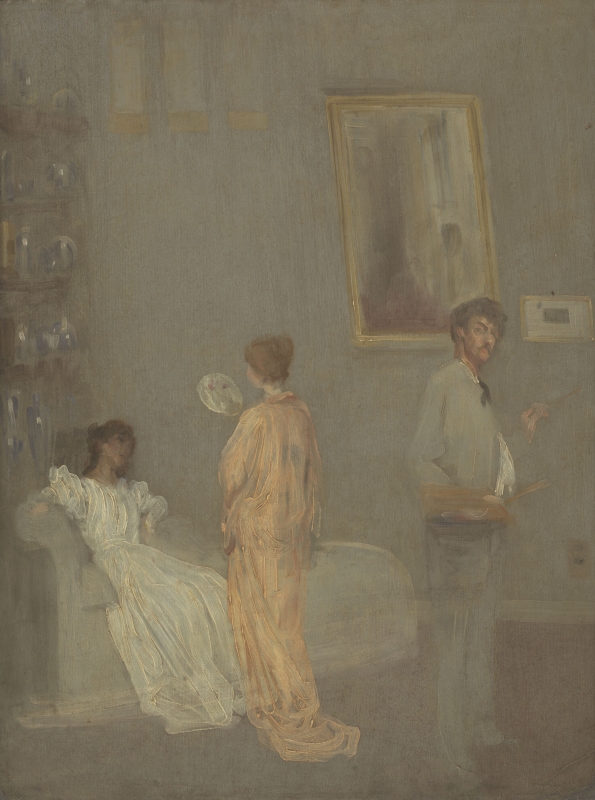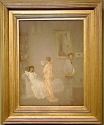Home > Catalogue > Browse > The Artist in his Studio (Whistler in his Studio) << >>
Composition
On 16 August 1865 Whistler said that he had painted a 'sketch' which included himself, Fantin-Latour, Albert Moore, and two women: 'Il y a toi et Moore, la fille blanche assise sur un canapé et la Japonaise qui se promène!' 1 It is immediately obvious that The Artist in his Studio (Whistler in his Studio), one of two similar sketches of a figure composition, includes the artist and two women but not the other two men.
However, an earlier configuration was revealed by recent visual and technical analysis at the Art Institute of Chicago, and described by Kimberley Muir. Infrared Reflectogram disclosed the existence of a seated male figure to left of centre, wearing a black cap or low, round brimmed hat and a dark jacket; he leans on his elbow on the end of the sofa, looking towards the seated figure of Hiffernan at left. 2 This figure was replaced and mainly concealed by the standing figure of 'la Japonaise'. There is no sign of another male figure or an alternative position for the standing woman: if they were scraped out, it must have been done very thoroughly.
The Artist in his Studio (Whistler in his Studio) is one of two paintings (the other is The Artist's Studio [YMSM 062]) that relate to a large picture Whistler intended to submit to the Salon in 1866. He described it in his letter to Fantin-Latour of 16 August 1865:
'J'ai pour le salon une réunion de nous autres à mon tour - j'en ai fait une esquisse qui est bigrement bien - ca représente l'intérieur de mon atelier - porcelaine et tout! Il y a toi et Moore, la fille blanche assise sur un canapé et la Japonaise qui se promène! ... les couleurs choisies sont charmantes. moi en gris clair - la robe blanche de Jo - la robe couleur de chair de la Japonaise (vue de dos) toi et Moore en noir - le fond de l'atelier gris - c'est en hauteur, et aura à peu près dix pieds de haut, sur six ou sept de large.' 3
According to Sir Hugh Percy Lane (1875-1915) Whistler painted it from 'a sketch' (The Artist's Studio [YMSM 062]), which would imply that The Artist in his Studio (Whistler in his Studio) was the second and more finished painting. 4 However, after certain alterations to the original composition had been painted over, it was still unfinished. Indeed, a reproduction of the painting published in the Pall Mall Budget on 2 February 1893 shows the head of the woman on the sofa before it was completed. 5 The art dealer Edward Guthrie Kennedy (1849-1932) noted on 12 July 1895 that Whistler was 'to put a head on the one on the sofa.' 6 Therefore, as Whistler told his brother, he 'touched up the little head in the studio picture' in Paris in July 1895. 7 Kennedy had wanted 'the face & hands of the woman finished, and the tonality not disturbed' but Whistler wrote that, 'artistically, the quality of the picture is not to be enhanced.' 8
Technique
In their biography of Whistler, the Pennells comment:
'He holds the small palette he sometimes used with raised edges to keep the liquid colour from running off, he wears the long-sleeved white waistcoat in which he worked, and he painted from the reflection in the mirror, for his brush is in his left hand.' 9
It was thinly painted in muted colours. Details, including the folds of the women's dresses, and Whistler's shirt, and the faces, were added in clearly visible separate strokes of creamy textured paint, as were the highlights on the blue and white porcelain and the gold picture frames. Kimberley Muir analysed the medium and materials involved:
'Whistler painted the work on board ... prepared with a red ground layer that contains a mixture of iron-oxide red and lead white. ... Over this, Whistler applied a relatively thick, overall pale-gray paint layer using long, vertical brushstrokes … followed, in some places, by a slightly darker bluish-gray layer. These broadly applied gray layers remain exposed to varying degrees ... providing much of the gray tonality in the final composition ... The gray layers were dry when Whistler applied very thin layers of medium-rich, translucent brown paint over the entire surface. The brown paint appears to have been added and wiped back in a process that allowed more or less of the light-gray paint to show through in different areas.' 10
Whistler's paints included lead white, red, yellow and brown iron oxide or earth pigments, vermilion, cobalt blue, ultramarine blue, and bone black, and added medium to his paint to achieve the desired fluidity. Muir adds interesting observations on the technique involved:
'Whistler built up the composition using both thin, fluid paint applications and more bodied paint brushed on in discrete and deliberate strokes with ridges of low impasto ... In general, the figures were quickly painted in single wet-in-wet sessions; however, ... the dress of the seated woman was clearly painted after the brushstrokes of the sofa were dry. The standing woman was added later … Whistler made a late change to the head of the seated woman. … The head is more densely painted than those of the other figures with paint that is relatively matte and fluid, apparently thinned with solvent. It overlaps the neck of the dress.' 11
Conservation History
On 4 May 1893 Whistler wrote to the picture restorer Stephen Richards (1844-1900),
'you will receive three other pictures - No. 1. A sketch of mine on Millboard called known as the Studio ... You will clean very delicately - getting rid of all the dirt, and then varnish beautifully - But be very carefull! [sic] … I leave all this in your hands and have great faith in your care & discretion as well as your skill.' 12
On the 27 May Francis Gerard Prange (b. ca 1843) reported, '"The Studio" has been in Richard's hands for a week. It is certainly improved and I have put about this fact of its being for sale in the right quarters.' 13
Muir explains that there is an overall natural-resin varnish layer, and yellowed natural-resin residues in the recesses of the paint texture from an earlier cleaning plus an additional layer of varnish applied at more recent date, and adds: 'The surface has an even, satiny sheen'. Despite minor paint loss, damage, and retouchings, the painting is in good condition overall. 14
Frame
Whistler-style frame dating from ca 1911. 15
Notes:
1: Whistler to Fantin-Latour, 16 August [1865], GUW #11477.
2: Kimberley Muir,'Cat. 8 The Artist in His Studio, 1865/66, 1895: Technical Summary,' in Whistler Paintings and Drawings at the Art Institute of Chicago, The Art Institute of Chicago, 2020, URL.
5: 'Mr. Whistler in His Studio', Pall Mall Budget, 2 February 1893, p. 163; reproduced in Stephanie L. Strother, 'Cat. 8 The Artist in His Studio, 1865/66, 1895: Curatorial Entry,' in Whistler Paintings and Drawings at the Art Institute of Chicago, The Art Institute of Chicago, 2020, URL.
7: Whistler to W. McN. Whistler, [24/31 July 1895], GUW #07017.
8: Kennedy to Whistler, 30 August 1895, Whistler to Kennedy, [12 September 1895], GUW #07257, #07258.
9: Pennell 1911 A [more], p. 129.
10: Kimberley Muir, 'Cat. 8 The Artist in His Studio, 1865/66, 1895: Technical Summary,' in Whistler Paintings and Drawings at the Art Institute of Chicago, The Art Institute of Chicago, 2020, URL.
15: Dr Sarah L. Parkerson Day, Report on frames, 2017.
Last updated: 4th December 2020 by Margaret








